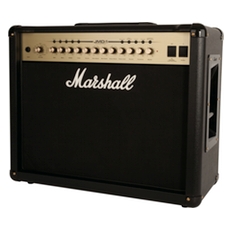 With a wide array of sounds that represent the best of Marshall amplifiers’ rich history, the JMD501 is an excellent amplifier that can be used in a wide variety of situations, particularly for the rock and blues player.
With a wide array of sounds that represent the best of Marshall amplifiers’ rich history, the JMD501 is an excellent amplifier that can be used in a wide variety of situations, particularly for the rock and blues player.
Few amplifier companies are as iconic as Marshall. The look of a Marshall 4×12 stack is as much a part of rock and roll history as the Fender Stratocaster or the Gibson Les Paul. They’ve also stayed pretty tried and true to their original roots. When you think overdriven tube amplifiers, Marshall is rightly one of the first names that comes to mind. When companies attempt to model classic amplifiers, they always include at least one if not several Marshall models, so you’ve got to wonder how Marshall would choose to model its own amplifiers? Enter the JMD1 series, which marries modern digital technology with traditional tube amplification. Designed in conjunction with Swedish software designers Softube, the JMD1 tries to capture the sound and feel of a fleet of Marshall amps. Did they succeed? Let’s find out.
Specifications
The Marshall JMD501 is a 50 watt amplifiier featuring a single 12″ Celestion G12-70MD speaker. The preamp models are based on Marshall’s new “Natural Harmonic Technology,” designed in conjunction with Softube. The result is 16 different preamps based on Marshall’s own amplifiers. The front panel features controls for gain, bass, middle, treble, volume, modulation adjust, modulation depth, delay adjust, delay level, reverb, and presence. Four different presets are available with separate sounds for clean, crunch, overdrive, and lead. The effects are also selectable from the front panel. The four presets may be overridden if you wish to use manual mode.
For that “real tube” feel and sound, the power amp sports 2 EL34 tubes and a single 12AX7 tube is used for the preamp. Onboard effects included chorus, phaser, flanger, tremolo, delay, and reverb. MIDI in and out jacks are included, as is an XLR output, 1/4″ headphone out, 1/4″ preamp out, and a switchable series/parallel effects loop.
Performance
Honestly, I was a bit hesitant to try out the JMD501 simply because in my experience it takes a company dedicated to amp modeling (such as Line 6 or Roland) to really pull it off well. I’ve never been really impressed with Marshall’s solid state amps, so my expectations were pretty low with this amp (though their rackmount JMP-1 preamp was a thing of beauty and should never have been discontinued).
Just to cut to the chase. My expectations about Marshall’s foray into digital modeling have been raised. This amp is a winner.
The issue with digital modeling has never been the quality of sounds themselves so much as the “feel” of the amplifiers, which is why even digital modeling purists like Line 6 have started incorporating tube technology into their amplifiers. Marshall was smart enough to leave the digital modeling to software geniuses Softube and focus upon their own strength, painfully loud tube amps!
Since it’s a Marshall, I immediately went for the throat and tried out some of my favorite Marshall amps just to see how the emulation fared. I have to say that I’m impressed overall and found the JMD501 to be very “Marshallesque” all the way around. A Marshall should have a nice, thick, beefy bottom end with bright highs to round out the package, and the JMD501 delivers. As a child of the 80’s, my favorite Marshall sound has always been the JCM800, and I was very pleased with the sounds. I’ve owned a few JCM800’s in my day, and the spirit of that classic amp is all here, as is the JCM2000, another favorite.
One product I was happy to see “reintroduced” in a manner of speaking was the amp’s JMP-1 model, based on Marshall’s rackmountable preamp that has been, unfortunately, discontinued. Setting 4 (“Natural”) really nails that fat JMP-1 clean sound, and helps make this amp extremely versatile.
To be frank, I didn’t find too many bad sounds in the JMD501. Does it sound and feel exactly like a pure tube amp? Not exactly, but that’s not bad. I would say that all of the good things about tube amps (responsiveness, feel) are here, but at higher volumes the JMD501 is a lot more forgiving than a normal tube amp. The response is a bit tighter, which is not a bad thing, yet it still has the tube-based warmth.
The onboard effects are, well, onboard effects. Personally, I prefer using my own pedalboard, but the effects are good, particularly the delay and reverb, but there’s not a lot of control. Still, they’re good for what they are and, if you need to leave your pedalboard at home and keep it simple, they can definitely work in a pinch.
Finally, the JMD501 offers a wide variety of switching ability for both the channels and the effects via MIDI or the footswitch.
Final Thoughts
It’s hard to think of “Marshall” and “digital” in the same sentence, but the JMD:1 series will likely make true believers out of everyone except the most diehard tube snob. With a wide array of sounds that represent the best of Marshall amplifiers’ rich history, the JMD501 is an excellent amplifier that can be used in a wide variety of situations, particularly for the rock and blues player.
Name of Gear: Marshall JMD501
List Price: $1,550.00
Manufacturer Info: Marshall Amplifiers; marshallamps.com
Pros: Excellent range of sounds from Marshall amplifiers; logical controls
Cons: Uninspiring onboard effects